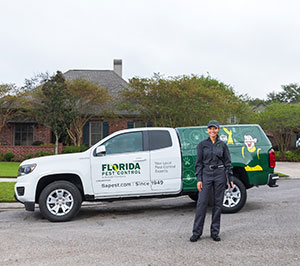Experienced A1 Exterminators Charlotte NC - Fast and Trustworthy Solutions
Experienced A1 Exterminators Charlotte NC - Fast and Trustworthy Solutions
Blog Article
Bed Pest Therapy Malfunction: Comparing Chemical Vs. Non-Chemical Solutions
In the world of bug control, especially when managing the consistent issue of bed pests, the option between chemical and non-chemical treatment services can be an essential one. Both methods offer unique benefits and downsides, influencing factors such as efficiency, security considerations, and total expense. By examining the nuanced information of each technique, a clearer understanding of which path to seek in attending to a bed bug infestation can be achieved.
Efficiency of Chemical Therapies
Chemical therapies for bed pest problems have been extensively identified for their rapid and powerful efficiency in eliminating these insects. When thinking about the performance of chemical therapies, it is critical to understand that they can provide a extensive and quick option to a bed insect problem.
Furthermore, chemical treatments have the benefit of offering recurring impacts, indicating that they can remain to eliminate bed insects even after the first application. This residual activity is especially valuable in combating any kind of prospective re-infestations. Furthermore, the rapid activity of chemical therapies can bring alleviation to individuals encountering serious bed bug invasions, enabling them to regain control of their space swiftly.
Safety Worry About Chemical Solutions
One essential element that requires careful consideration when utilizing chemical solutions for bed pest therapy is ensuring the safety and security of owners and the setting. Direct exposure to particular chemicals made use of in bed pest therapies can lead to breathing problems, skin irritation, or other unfavorable responses, specifically in people with pre-existing conditions or level of sensitivities.
In addition, the ecological effect of chemical solutions is another considerable consideration. Some pesticides made use of in bed insect treatments might be damaging to helpful bugs, wildlife, and ecosystems if they seep right into the dirt or water systems. It is necessary to utilize chemical treatments judiciously, adhering to security standards, and thinking about less poisonous options to mitigate these dangers and ensure the safe and reliable monitoring of bed bug infestations.
Advantages of Non-Chemical Techniques
Thinking about the possible security issues and environmental effect related to chemical options for bed pest treatment, discovering non-chemical methods offers an appealing choice with several distinctive benefits. Non-chemical techniques offer a safer choice for homes, particularly those with people, family pets, or youngsters delicate to extreme chemicals. These methods get rid of the dangers of direct exposure to poisonous substances, minimizing the potential for damaging health impacts. In addition, non-chemical therapies are eco-friendly, as they do not add to air or water air pollution, making them a sustainable choice for pest control.
In addition, non-chemical services can be efficient in targeting bed insects, including hard-to-reach areas where chemical therapies might not pass through. Techniques such as warm treatment, vacuuming, steam cleansing, and bed mattress encasements offer complete obliteration without the usage of unsafe chemicals. Moreover, non-chemical strategies can be much less disruptive, requiring marginal prep work and enabling quicker reentry into treated locations. Generally, choosing for non-chemical bed insect therapy techniques not only focuses on security and environmental management but additionally makes sure comprehensive and reliable insect control.
Limitations of Non-Chemical Treatments

Furthermore, non-chemical treatments usually call for several applications to achieve effective elimination. This can be lengthy and might not constantly ensure complete removal of all bed bugs and their eggs, specifically in concealed or hard-to-reach places.
Furthermore, the success of non-chemical therapies heavily counts on appropriate execution and thoroughness, which can be testing for individuals without specialist proficiency. Poor application of non-chemical techniques might result in incomplete obliteration, resulting in relentless invasions and the need for added treatments.
Consequently, while non-chemical treatments have their benefits, it is important to recognize these limitations and consider them when establishing the most efficient approach for handling bed bug problems.
Cost Comparison: Chemical Vs. Non-Chemical Options
Offered the limitations related to non-chemical treatments, an essential element to evaluate in the context of bed bug administration is the cost comparison between chemical and non-chemical choices. Chemical therapies typically include the application of insecticides by experts, which can range from $250 to $900 per room, relying on the severity of the infestation and the size of the location to be dealt with. In comparison, non-chemical therapies like heat treatment or heavy steam can be extra expensive, with costs ranging from $1,000 to $6,000 for A1 charlotte bed bug exterminator an entire home. While the initial expense of chemical therapies might appear reduced, multiple treatments may be needed to totally eradicate the infestation, potentially increasing the overall price. On the other hand, non-chemical options may provide a more green and sustainable remedy, although they can be cost-prohibitive for some people. Inevitably, when considering the cost of bed bug treatment options, it is necessary to weigh the ahead of time expenditures against the performance and long-term sustainability of the selected approach.
Final Thought

Taking into consideration the prospective security problems and ecological influence associated with chemical options for bed insect therapy, discovering non-chemical techniques presents an encouraging option with several distinctive benefits.Given the constraints associated with non-chemical therapies, a vital aspect to examine in the context of bed bug management is the expense contrast between chemical and non-chemical alternatives. In contrast, non-chemical therapies like warm treatment or vapor can be much more pricey, with costs varying from $1,000 to $6,000 for an entire home. While the first expense of chemical therapies may appear reduced, several therapies might be needed to totally eliminate the problem, potentially boosting the overall price.In final thought, when contrasting chemical and non-chemical bed insect therapy alternatives, it is necessary to think about effectiveness, security, advantages, limitations, and expense.
Report this page